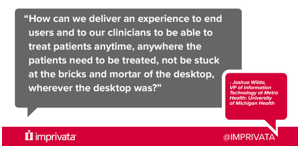A Virtualized Healthcare Environment: The keys to improving Metro Health: University of Michigan Health’s clinical and patient experience
I recently sat down with Joshua Wilda, VP of Information Technology at Metro Health: University of Michigan Health, a 208-bed teaching hospital in western Michigan, to discuss virtualization.
In 2007, Metro Health: University of Michigan Health moved into a new state-of-the-art facility with the goal of improving their clinical and patient experience by allowing clinicians to treat patients anytime, anywhere, not necessarily behind one desktop. Partnering with VMWare View, Metro was able to speed up clinical workflows and reduce hospital costs. To further expand their virtual environment, Metro paired VMWare View with Imprivata OneSign for Single Sign-On (SSO) to give care providers increased security when roaming between clinical desktops and applications.
Today, nearly 2500 clinicians and staff use the system on an average work day, which improves the hospital’s efficiency while saving an average of 10-15 million dollars a year. Virtualization allows Metro clinicians to travel between appliances with their working session following them. They are also using virtual desktop infrastructure (VDI) for vendor- access. Using Imprivata, IT employees control security access through the VMware View sessions, preventing rogue vendors from impacting their servers.
In the interview recording below, Joshua explains why Metro chose to implement virtualization, the successful impact it has had on the user and clinical experience, and how others in the healthcare field can implement VDI into their hospital setting.
Here are some of my favorite quotes from the interview:

Joshua on deploying virtualization…
“We started down the path with VMWare and got really introduced to them early on. We were able to partner with VMWare to push the envelope with the EMR vendor so they adopted it as a platform. Imprivata single sign-on, as we were introduced to it, was very key for us. SSO really allows us to adopt that deployment of “we’re going to get you to what you need as quick as we can.” With SSO, there’s a lot more federated access to have a very secure password and it allows us to adopt the applications to follow you along with the desktop – quick and easy access right when the patient needs to be seen.”
Joshua on the results…
“When you’re using a desktop, you’re stuck at a desktop. When you’re using View, I’ve had physicians treat patients while they were on vacation because they can log in to their VDI desktop. Only VDI can do that.”
Joshua on best practices for implementation…
“First, think outside the box. You really have to deconstruct yourself from what you might traditionally experience from that infrastructure and not be afraid to take this leap. Second, get your users experiencing it. It is important to educate not on what a VDI session is, but how it can be used for patient care. Third, really think about the patient and how you can use that VDI session anytime, anywhere, to treat the patient. Think about how and where you can deliver this experience in a fast and easy way.”
Joshua on the reaction from clinicians…
“As you can imagine being in Michigan, we have Michigan State fans. We got a telephone call from one of our cardiologists, who launched View from his Smart TV in between the halftime of a Michigan State game and he thanked us for him not having to miss the game. He was there right on his smart TV looking at patient charts and we thought that was pretty cool.”
